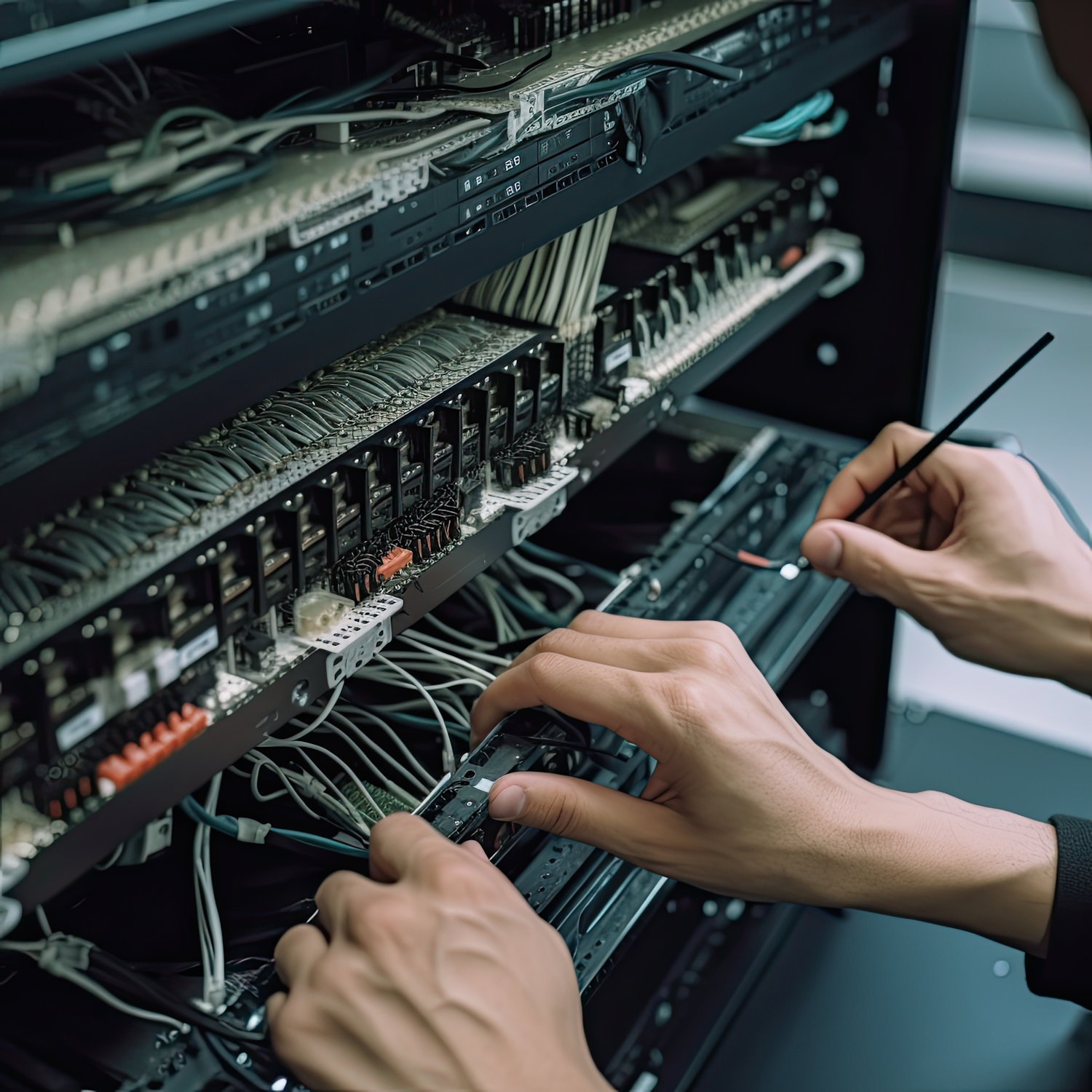5 Common Network Installation Mistakes
Modern organisations whether government agencies, schools, healthcare providers, leisure venues, industrial firms, or businesses rely on robust networks for daily operations.
A well installed network ensures operational reliability and high quality IT infrastructure. However, even experienced teams can make mistakes during a network installation that lead to downtime, poor performance, and unnecessary costs. Below we outline five common network installation mistakes and how to avoid them, with a focus on keeping your business running smoothly.

Mistake 1: Insufficient Planning and Assessment
Jumping into a network deployment without thorough planning is a recipe for trouble. Inadequate up front assessment of requirements often results in networks that cannot meet an organisation’s needs. Common planning oversights include failing to map out coverage areas, device capacity, future growth, and environmental factors.
For example, a wifi setup for an office might not account for high density usage in conference areas, or a hospital network upgrade might ignore critical medical device connectivity needs. Lack of planning can lead to bottlenecks or dead spots, requiring costly rework later.
How to Avoid It: Dedicate time for a comprehensive network design phase. Conduct site surveys (including a professional wifi survey for wireless needs) and audit your current IT infrastructure. Calculate bandwidth and business internet services requirements based on user count and application usage.
Explore experiences IT infrastructure services early, professional business IT solutions providers can assess your environment, design a scalable architecture, and ensure compliance with industry standards. Thorough planning might include coordinating with commercial electrical contractors to verify power, grounding, and pathway considerations.
Mistake 2: Poor Cable Selection and Management
Using the wrong type of cable or poor quality components is a frequent error. For instance, installing outdated Category 5e cables where Category 6 or fibre is needed will limit network speed and bandwidth. Similarly, neglecting cable management such as not labelling cables, running data cables parallel to power lines, or creating tangled messes in server rooms leads to interference, difficulty in troubleshooting, and even safety hazards.
How to Avoid It: Invest in proper cabling and structured installation from the start. Choose cable types that meet or exceed your requirements (e.g., Cat6 or Cat6a for gigabit/10G needs, fibre optic for long distances). Adhere to length limits (typically 100 meters for Ethernet runs) to avoid attenuation and signal loss.
Utilise network cabling best practices: route cables neatly on trays or racks, use cable ties/Velcro for organisation, and label both ends of every cable. Keep data cables away from sources of electromagnetic interference (for example, do not run Ethernet cables tightly parallel to electrical wiring).
It’s also crucial to follow building codes and fire regulations use plenum rated cables in air handling spaces and comply with industrial electrical services standards for safe, reliable installations. Working with professional data cabling companies can ensure these details are handled.
A qualified network installation team will provide clean, well documented cabling infrastructure that supports optimal performance and makes future changes easier.
Mistake 3: Neglecting Wireless Coverage and Capacity
Many organisations install a few wireless access points without a design, resulting in weak signals, dead zones, or oversaturated access points that can’t handle the device load. Poor wifi installation planning is especially harmful in environments like schools (with hundreds of student devices), hospitals (where reliable wireless is needed for patient care devices), or large offices and leisure venues (where guests and staff expect seamless connectivity).
Insufficient wireless coverage or bandwidth can disrupt business operations and user experience. Another aspect often overlooked is ensuring the internet bandwidth can support all the wireless usage. Upgrading internal Wi-Fi without adequate WAN business internet services will still bottleneck your network.
How to Avoid It: Plan your business WiFi deployment with the same diligence as wired networking. Perform a WiFi survey to map signal strength and identify interference (like walls, metal structures, or other electronics) before installation.
Design for capacity by segmenting users (e.g., separate guest Wi-Fi and corporate networks) and deploying enough access points to handle peak loads. Use enterprise grade office WiFi solutions with centralised controllers or cloud managed systems for better performance and manageability.
Ensure proper placement and installation of APs (ceiling-mounted is often ideal for coverage). Also, consider future wireless needs: voice over WiFi, IoT devices, or expansions to new areas. If your operations rely on cloud applications or heavy downloads/uploads, work with your ISP or business internet services provider to secure adequate bandwidth and redundancy.
Mistake 4: Ignoring Security and Future Proofing
Another common pitfall is overlooking security and long term scalability during network installation. Some organisations focus solely on immediate needs and ignore critical security measures like network segmentation, firewall configurations, and physical security integrations. The result can be a network that functions but leaves serious vulnerabilities or cannot adapt to new demands.
For example, failing to account for CCTV installation and other security camera installation on the network can overwhelm the system later if dozens of high definition cameras are added without proper switches or VLAN planning.
Similarly, not considering access control systems (secure door entry, IoT sensors, etc.) during the install may lead to fragmented security infrastructure that’s hard to manage. On the scalability front, not building in extra capacity or using outdated technology can mean ripping out and replacing components sooner than expected.
How to Avoid It: Work with your IT team or an enterprise IT solutions provider to incorporate cybersecurity best practices from day one—this includes using business-grade firewalls/routers, setting up secure Wi-Fi authentication, and segmenting traffic (for example, isolating business security devices like cameras on their own network segment).
Integrate physical security solutions into the network thoughtfully; if you plan to deploy CCTV or commercial security systems (like IP cameras, alarm panels), ensure your network switches support Power over Ethernet (PoE) and that you have sufficient ports and bandwidth for these systems. The same goes for office security and building access controls that may use the network.
It’s easier and more cost effective to run extra cable drops and install necessary hardware during the initial project than to retrofit later. Also, choose modern, scalable equipment whenever possible. Opt for network switches, wireless access points, and servers that can handle higher loads or be easily upgraded.
Mistake 5: Skipping Testing and Ongoing Support Plans
Once the cables are run and hardware is plugged in, the project isn’t over yet many organisations fail to thoroughly test the new network or plan for its maintenance. Skipping the testing phase is a major mistake that can leave latent issues undiscovered until they cause failures later. It’s crucial to verify that every cable terminations, switch port, wireless AP, and device is functioning as intended.
Equally important is documentation: without clear network diagrams, cable labels, and configuration backups, even simple troubleshooting can become a nightmare down the road. Another related mistake is not arranging for IT support services post installation. Networks require updates, monitoring, and occasional fixes. If there’s no support plan, you might find yourself scrambling when an outage occurs.
How to Avoid It: Treat testing and support as mandatory components of network installation. After setup, perform comprehensive testing of the infrastructure: certify all cable runs with proper tools, ping test all connections, and ensure Wi-Fi coverage matches the plan.
Any identified issue (a faulty cable, a misconfigured router, etc.) should be fixed before the network goes live. Document everything; IP address inventories, equipment lists, and label all ports and patch panels for clarity. This documentation will be invaluable for future upgrades or troubleshooting.
If you have an internal IT team, make sure they are trained on the new systems. If not, consider outsourced IT support or a managed IT support services contract with a trusted provider. Professional IT installation firms often include warranty and support periods; take advantage of these and have a clear computer support or business IT help arrangement in place.
Ongoing maintenance (like applying firmware updates, checking backups, monitoring performance) can often be handled by an external IT services partner if you don’t have the resources in house.
Conclusion
A successful network installation is not just about running cables and plugging in hardware. It’s about thoughtful planning, quality execution, and proactive management. By avoiding these five common mistakes, organisations can achieve a network that is fast, reliable, secure, and ready for future needs.
FAQs
About Nortech Network Services
At Nortech, we are an independent IT infrastructure company with offices in Northampton and Milton Keynes. Since 2000, we’ve helped businesses across the UK get connected, stay secure, and work smarter.
From cabling and wireless to AV, security, and IT support, we handle the lot. Our engineers know their stuff, and because we’re vendor-neutral, you get advice that’s honest and cost-effective.
If your systems are slow, outdated or holding your business back, give us a call. We’ll help you sort it out without the jargon or drama.


